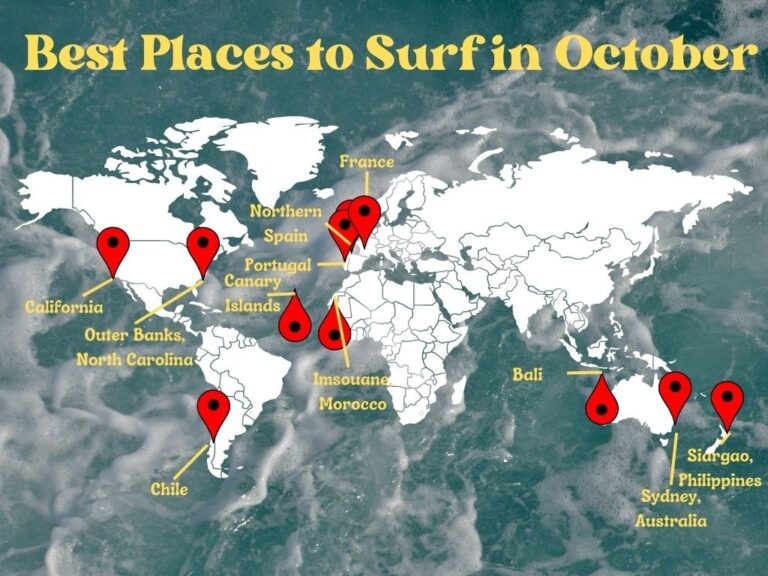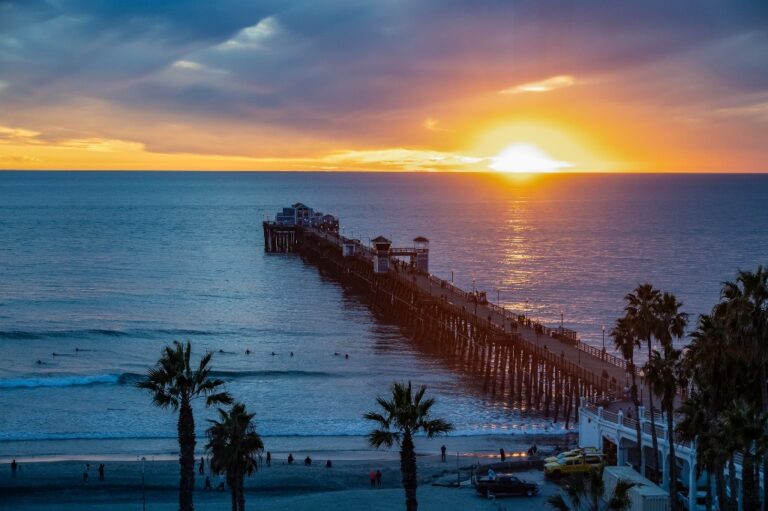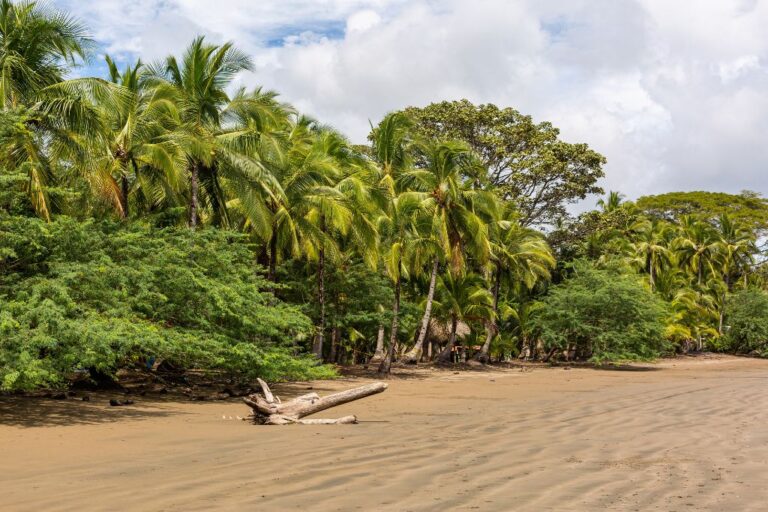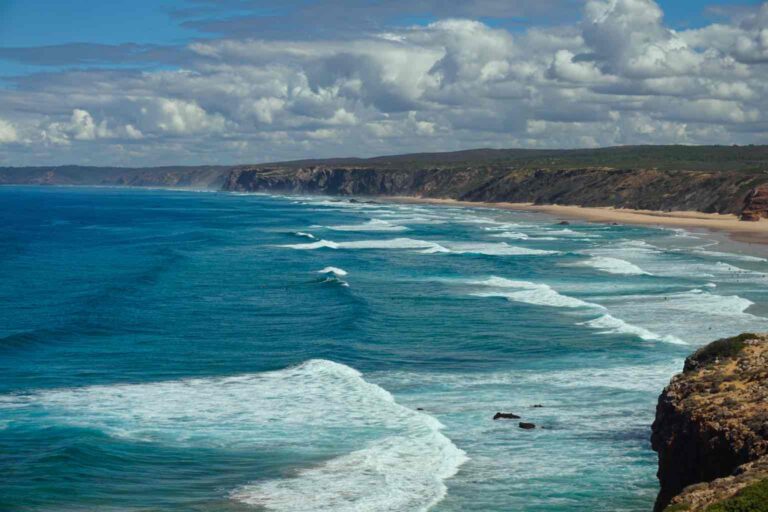9 Biggest Waves in the World
From the tropical, crystal clear waters of Tahiti, to the cold, rugged, cliffside breaks in Ireland- this guide covers the biggest waves in the world.
When most people think of surfing, it’s likely that images of cruisy longboarding waves come to mind, reminiscent of the waves Robert August and Mike Hynson sought all over the world in the Endless Summer. However, the big wave surfers of the world seek something a little different: thundering, 75 foot walls of water at Nazaré, and the pure adrenaline that comes from racing through a barrel section only breaking over 4 feet of water in Tahiti. Here are 9 of the biggest waves in the world:
** This article contains affiliate links. As an Amazon Associate, I earn from qualifying purchases. Meaning, at no extra cost to you, I earn a small commission anytime you purchase any of the linked products. Thanks for your support of Gathering Waves!
1. Nazaré, Portugal

Nazaré is a small fishing village located off the west coast of Portugal. This small Portuguese town is home to the largest wave in the world: Praia do Norte. The big swell season in Portugal runs from October to March, and during this time, waves are frequently 65 feet+! On exceptionally large days, the waves in Nazaré get up to an impressive 100 feet tall!
Every year, some of the bravest and most brazen big wave surfers come from all over the world to surf Nazaré. In fact, the record for the largest wave ever surfed was set at Praia do Norte, by Sebastian Steudner, who caught a wave that was 86 feet tall.
If you want to watch the massive waves at Nazaré, you have two options: You can watch from the beach, or at the lighthouse, where you pay 2 euros to go on the roof and enjoy the best views in the house.
What makes the waves in Nazaré so big?
The behemoth waves in Nazaré exist thanks to a massive underwater canyon that runs parallel to shore. The underwater canyon is 16,000 feet deep (5,000 meters) and 142 miles long (230 kilometers). The Nazaré Canyon is the largest underwater canyon in Europe, and is also far deeper than the Grand Canyon.
How can I watch the big waves at Nazaré?
If you want to see big waves at Nazaré, you’ll have to come during the Portuguese swell season, which runs from October-March. However, you’re more likely to see the big waves if you come to Portugal between November and March.
For flights, you can fly into either Lisbon or Porto. Lisbon is about a 90 minute drive from Nazare, and Porto is about 2 hours, so not bad either way.
Once you’ve booked your flights, I recommend renting a car and driving to Nazaré to watch the surf. Driving in Portugal is super safe and easy, and it gives you a lot more flexibility than you’ll have relying on public transportation. If you’re only coming to watch the surf, you can book a hotel and stay right in Nazaré.
However, if you’re also coming to surf, I recommend staying in either Ericeira or Peniche so you can surf there, and drive up (or down) to Nazaré as a day trip. There are lots of great surf camps and surf hotels in both Ericeira and Peniche, so you won’t have a hard time at all finding an amazing place to stay.
2. Jaws, Maui (Pe’ahi)
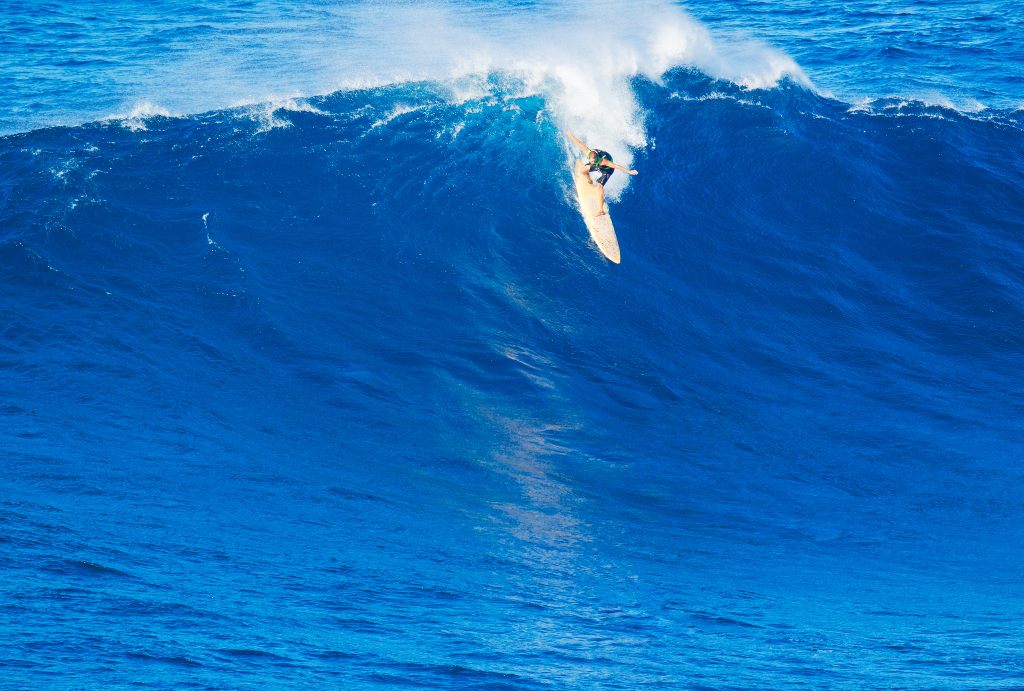
Jaws, or Pe’ahi, is located on the north shore of Maui, and is not only the biggest wave on the island, but also one of the biggest waves in the world. The big surf season for Jaws is between December and March, where the waves at Pe’ahi can get up to 60 feet tall! According to Redbull, the biggest wave ever surfed at Jaws was 71 feet tall, ridden by Yuri Soledad in 2016. However, in January of 2021, Makua Rothman surfed what was estimated to be a 100 foot wave at Jaws, which would be a new record for the biggest wave ever surfed. This seems to be an unofficial estimate, as the title for biggest wave ever surfed still belongs to Sebastian Steudner, for an 86 foot tall monster wave at Praia do Norte.
What makes the waves at Jaws so big?
Similar to Nazaré, the waves at Jaws owe their power to a hundred foot underwater trench, and powerful north swells. The trench is right next to a shallow coral reef, where the water is only 20 feet deep, which is where the waves break.
How can I watch the big waves at Jaws?
If you want to see the monster waves breaking at Jaws, you’ll have to come to Maui during the swell season, from December-March, and have a little bit of luck on your side that the wave is actually working. Once you’re in Maui, you’ll want to rent a car, and drive to the viewing area. The road gets really bad and muddy, so it’s recommended to only go with a 4×4 vehicle.
3. Mavericks, California

Mavericks is another of the biggest waves in the world, and it’s located just outside of Half Moon Bay on California’s rugged northern coastline. Mavericks was a bit of a secret in the surfing community, until it was discovered by three Santa Cruz surfers: Alex Matienzo, Jim Thompson, and Dick Knottmeyer. However, Jeff Clark is the most famous for surfing Mavericks alone for 15 years before it became famous in 1990. Today, Mavericks is one of the most well-known big wave surfing breaks in the world, and the massive wave breaks up to 60 feet tall.
If you’re intrigued by Mavericks, I really recommend reading the book Making Mavericks by Frosty Hesson and Ian Spiegelman.
What makes the waves at Mavericks so big?
The waves are big at Mavericks thanks to its unique underwater rocky reef. When the north swells come at just the right angle, they come from the deep water and hit the underwater rock ledge, creating the monster waves at Mavericks that we know.
How can I watch the big waves at Mavericks?
If you want to watch the big waves at Mavericks, you’ll have to head on over to Half Moon Bay during the northern California swell season, which takes place between November and March.
If you’re looking to catch some waves yourself, I recommend booking a hotel in Santa Cruz and enjoying the surf there, and driving about an hour and 10 minutes up the scenic CA Highway 1 to see the waves breaking at Mavericks as a fun day trip.
4. Teahupoo, Tahiti
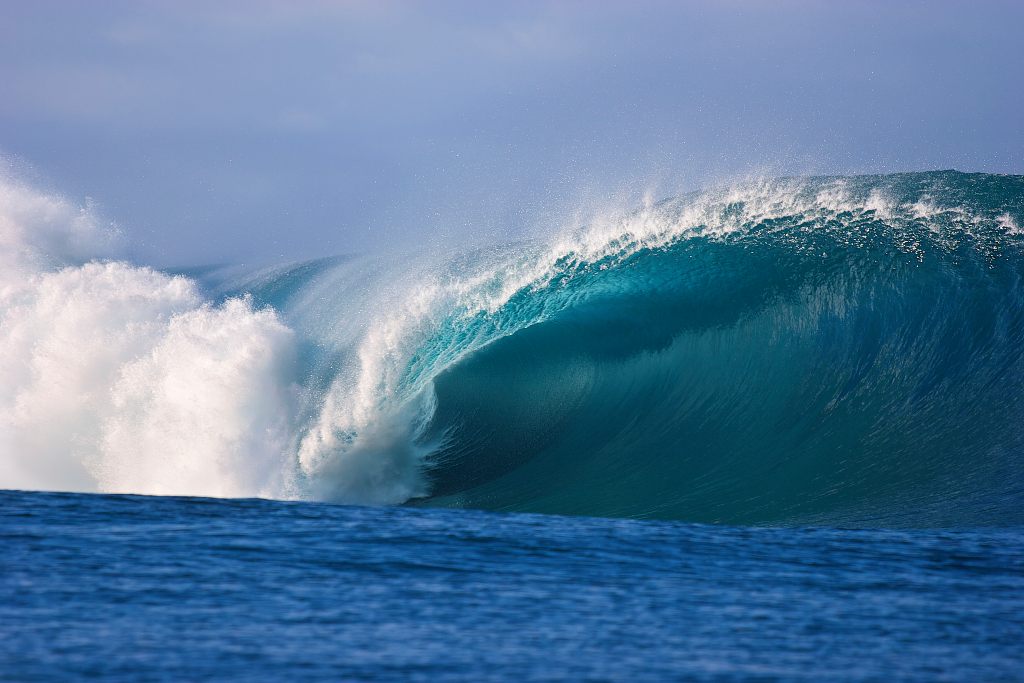
Teahupoo, located on the southwest coast of Tahiti in French Polynesia, is another world-famous big wave surf spot. The left-hand reef break at Teahupoo is incredibly powerful, with heavy barrels that challenge even the most hardcore, big wave surfers. The biggest the waves at Teahupoo get is around the 20 foot range, but at that size it’s just as critical, if not more so than a beach break double that wave height.
What makes Teahupoo particularly deadly is its shallow and jagged reef, which creates thick, hollow barrels that are both exhilarating and dangerous to ride. In some spots, the wave is breaking in just 4 feet of water above the reef.
The wave breaks about 500 meters away from shore, and while Teahupoo isn’t the tallest wave in the world, it’s insanely heavy, and absolutely belongs on the list of the biggest waves in the world.
The biggest waves at Teahupoo really get going during the southern hemisphere’s winter season, which runs from May to September, when the south swells hit.
The break’s legendary status is further cemented by the annual Billabong Pro Tahiti surfing competition, which draws the top surfers from all around the world to compete at Teahupoo.
5. Belharra, France

Belharra, situated in the Basque Country of France near Saint-Jean-de-Luz, is another famous and formidable surf spot, and one of the largest waves in the world.. This notorious wave has been known to break over 60 feet tall. Belharra is a reef break that churns over a reef covered in sea grass, located around 1.5 miles offshore. The prime time to catch Belharra’s waves is from December to March, when the region is pounded by massive winter swells. However, catching the perfect set requires optimal conditions of a big groundswell, low tide, and offshore winds. Even with all these elements in place, it’s not for the faint of heart, and Belharra is rarely crowded, save for a few brave big wave surfers.
6. Shipstern Bluff, Tasmania

Shipstern Bluff is a notorious surf spot located off the coast of Tasmania, Australia, and is renowned for producing some of the largest and most dangerous waves in the world. The break is situated in a remote location and can only be accessed by boat or a long hike through the Tasman National Park, adding to its exclusivity and allure.
The waves at Shipstern Bluff are generated by massive swells from the Indian Ocean and can reach heights of up to 20-30 feet or more. The best time to catch the biggest waves at Shipstern Bluff is during the winter season, between April and September when the region experiences powerful storms and high winds. However, the waves at this surf break are notoriously difficult to surf. The wave is known for its unique shape, which includes a heavy barrel section, and then a death defying section where the wave drops out from under your board. And if that’s not enough, the water around Shipstern Bluff is absolutely infested with white sharks.
7. Punta de Lobos, Chile
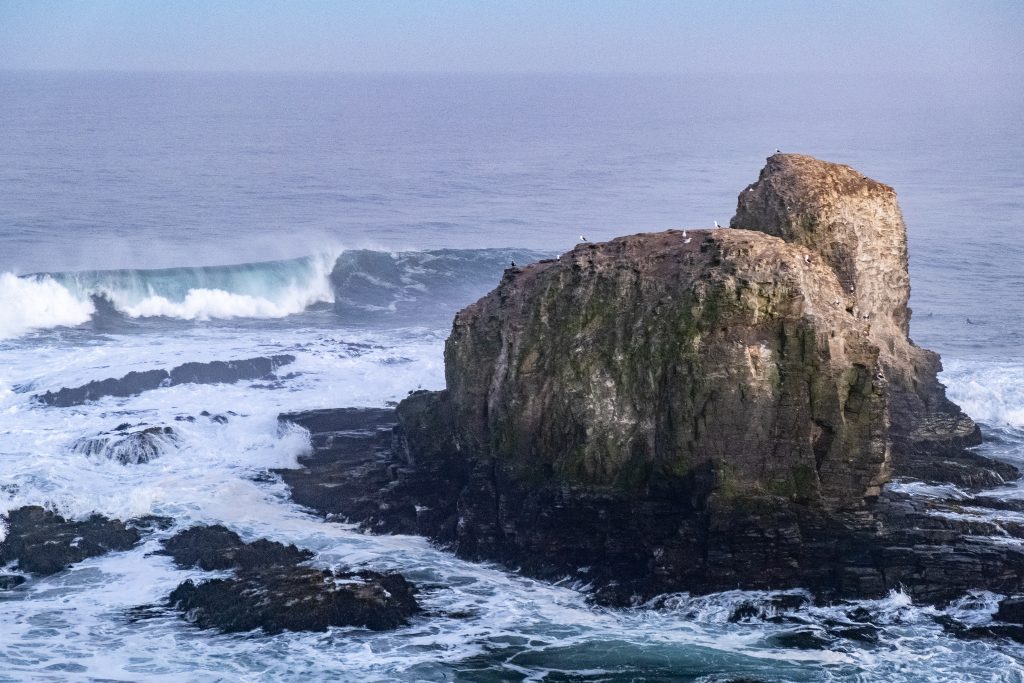
Punta de Lobos is a world-class surf spot located in Chile, famous for its consistent and powerful waves that attract surfers from all over the globe. The break is situated in the small coastal village of Pichilemu, about a three hour drive from Santiago, and is renowned for its long, barreling left-hand waves that can reach heights of up to 20-30 feet.
The best time to catch the biggest waves at Punta de Lobos is during the winter season, between April and September when the Southern Hemisphere experiences powerful swells generated by storms in the Pacific Ocean.
The break is unique in that it’s a point break, which means the waves break along the coastline, creating long, peeling waves that offer surfers an endless ride. This surf break isn’t just for big waves either- it works anywhere from one foot up to the thirty foot range. Additionally, Punta de Lobos has a rich history of big wave surfing and has hosted numerous international surf competitions, including the Quicksilver Big Wave Invitational.
8. Cortes Bank, CA
Cortes Bank is a legendary big wave surf spot located approximately 100 miles off the coast of San Diego, California. The underwater seamount rises from the ocean floor to within just a few feet of the surface, creating massive swells that can produce some of the biggest waves in the world.
The best time to catch the biggest waves at Cortes Bank is during the winter season, between November and February, when the Pacific Ocean experiences its strongest storms and swells. The waves at Cortes Bank can reach heights of over 60 feet, with occasional reports of waves as big as 100 feet. The break is notorious for its fickle and unpredictable nature, with surfable conditions only occurring a few days out of the year.
Despite the challenges, Cortes Bank has attracted some of the world’s top big wave surfers, including Mike Parsons, who famously caught a 75-foot wave there in 2008, earning him a place in the Guinness Book of World Records for the largest wave ever surfed. However, surfing at Cortes Bank comes with its fair share of risks, as the area is known for its abundant population of great white sharks.
9.Mullaghmore Head, Ireland
Mullaghmore is a big wave surf spot located in County Sligo, Ireland. The break is situated on the west coast of Ireland, facing the powerful swells of the North Atlantic Ocean. The waves at Mullaghmore are known to reach heights of up to 50 feet or more, making it one of the biggest and most challenging surf spots in Europe. The best time to catch the biggest waves at Mullaghmore happens during the winter season, between November and March, when the Atlantic receives the strongest swells and storms.
The break is also known for its heavy and unpredictable waves, which can create dangerous conditions for surfers. Not to mention this left hand wave breaks right in front of a rocky cliff. In addition to its challenging surf, Mullaghmore Head is also one of the coldest big waves in the world.
Wrapping up the Biggest Waves in the World
These nine waves are some of the biggest and most powerful in the world, attracting surfers and spectators from all over the globe. If you ever find yourself in the vicinity of one of these big wave surf breaks when they’re working, it’s 100% worth it to watch.
So if you’re looking for an adventure, consider planning a trip to one of these iconic big wave surf spots. Plus, most of these surf breaks have more manageable breaks not far away, so you can get some waves more suitable for us mere mortals while you’re at it.



